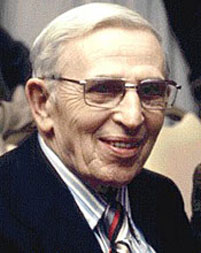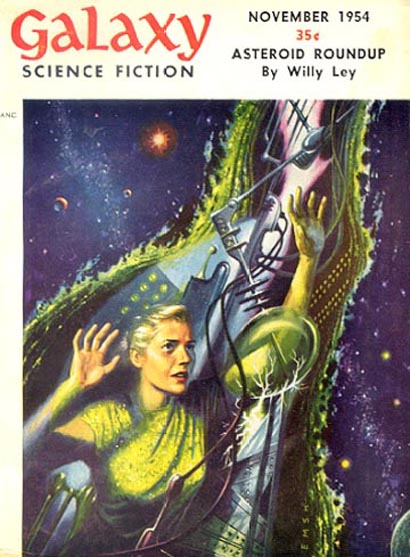
 Bowing to the overwhelming popularity of last week’s Clifford D. Simak X Minus One story “Drop Dead,” we are breaking tradition and offering another Cliff Simak story, back to back, as it were, and a first. X Minus One aired Cliff’s “How-2” on April 3, 1956. It first saw print in the November 1954 issue of Galaxy as a novelette. While the tone is seemingly rather light-hearted, there is a lot going on under the radar with several, more serious issues as the relevant themes. Without giving away specifics and thus spoilers, we have sentient, self-replicating robots (a Singularity topic), corporate gains taxation and thus the primary economic issue at the heart of the story, and to top things off a (secondary) conflict involving the rights of sentient robots adjudicating as legal lawyers upon which hangs the all-important (and aforementioned) primary tax issue.
Bowing to the overwhelming popularity of last week’s Clifford D. Simak X Minus One story “Drop Dead,” we are breaking tradition and offering another Cliff Simak story, back to back, as it were, and a first. X Minus One aired Cliff’s “How-2” on April 3, 1956. It first saw print in the November 1954 issue of Galaxy as a novelette. While the tone is seemingly rather light-hearted, there is a lot going on under the radar with several, more serious issues as the relevant themes. Without giving away specifics and thus spoilers, we have sentient, self-replicating robots (a Singularity topic), corporate gains taxation and thus the primary economic issue at the heart of the story, and to top things off a (secondary) conflict involving the rights of sentient robots adjudicating as legal lawyers upon which hangs the all-important (and aforementioned) primary tax issue.
The parallels with current issues of taxation — capital gains taxation in particular — couldn’t be more relevant in today’s ongoing ideological debate over the issue of taxes; who should be taxed, for what should they be taxed, and the amount they should be taxed, and just why — and what those seek to do when they believe they are over- or unfairly-taxed. Do they hide their money for which they have already been taxed once if unable to meet further tax obligations (or simply–somehow–illegally make more money out of thin air like the government does, legally, to finance debt)? Seek legal recourse, as in this story? Sell assets (close companies or lay off workers, for one solution) to avoid increased taxes instead of, perhaps, investing or expanding? Cliff Simak was concerned enough about the general issue to toss it gently into the air, blow it with a puff of science-fictional breath into the future (as he saw it in 1954), and write about one possible outcome (not necessarily answering all of the above related questions, but by implication…). But as in most good science fiction of this sort, it asks more questions than it answers, whether stated explicitly or not, and is why we like it.
Simak’s simple premise begins with the seemingly innocuous introduction of a “How-2” do-it kit in his story’s down-to-earth mundane, everyman future, where one poor guy finds himself at the mercy of self-replicating robots (i.e. an outside source working for his best interests, ala Jack Williamson’s classic “With Folded Hands”) who wish only to provide everything for him (as does self-replicating, ever-expanding government: my personal commentary only, forgive me, but it seems to fit and isn’t that much of a stretch especially in light of the similar theme of Williamson’s story). But at what cost? A rather similar take (though from a totally different angle) on the same theme is Robert Sheckley’s “Something for Nothing” presented in our April 28th episode here.
The greatest value in watching or listening to — at least relatively-faithful adaptations of — TV or movie or radio SF/F classic stories is in their ability to ask the intelligent viewer or listener to think, and to perhaps reconsider or at the very least honestly question previously held beliefs. Some beliefs may be confirmed, some others not. That said, there is no substitute for reading the printed word in the original text. Something with which I feel positive every published author would readily agree.
Along with Simak’s novelette “How-2” in the November 1954 issue of Galaxy were the following stories: “The Nostalgia Gene” by Roy Hutchins (short story), “The Laxian Key” by Robert Sheckley (short story), “The Music Master of Babylon” by Edgar Pangborn (novelette), “Up for Renewal” by Lucius Daniel (short story), “The Age of Kindness” by Arthur Sellings (short story), and “Big Ancestor” by F. L. Wallace (novelette).
I encourage anyone wishing to discuss the issues raised here, by me or the story, or on any other topic, to visit the sff.net newsgroup link on our homepage, or directly here. Comments are always welcome, pro or con — if polite.
In the meantime, please enjoy Clifford D. Simak’s “How-2,” a story featuring one of his favorite recurring subjects — robots — but in an entirely different light given the subject matter.
Play Time: 28:28

(Cover by the incomparable Ed [Emsh] Emshwiller)